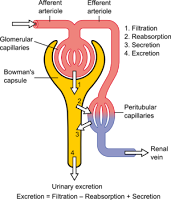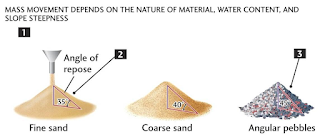RENAL CLEARANCE
Definition:
- It is the volume of blood from which the drug is totally removed in unit time through renal excretion.
- Expressed as CLR
- It has units : mL/min
- Major Organ for Excretion of Drugs is the Kidney.
- Functional Units are
- Nephron
- Bowman‘s Capsule
- Proximal Tubule
- Loop of Henle
- Distal Tubule
- Collecting Duct
- CLR = Rate of urinary excretion / Plasma drug concentration
- Physiologically,
- CLR = Rate of Filtration + Rate of Secretion - Rate of Reabsorption
- Plasma drug concentration (C)
Normal values of:
- Renal blood flow (RBF) = 1200 ml/min
- Glomerular filtration rate (GFR) = 125 ml/min
- Urine flow = 1.5 ml/min.
Creatinine clearance:
- CLcr = Rate of creatinine excretion in urine
- Serum creatinine in mg%
- CLcr = (140 – Age)*W
- 72 * Scr
For Females:
- CLcr = (140 – Age)*W = 0.9*Clcr of males
- 85 * Scr
- Where,
- CLcr = creatinine clearance in ml/min
- Scr = serum creatinine in mg%
- W = weight in kgs.
- Age = in terms of years.
- Normal creatinine clearance values: 120-130 ml/min
- Value of 20-50 ml/min : moderate renal failure
- Value of < 10 ml/min : severe renal impairment
Inulin Clearance:
This is for inulin, and yields the glomerular filtration rate.
- Value for normal males: 124.5 ± 9.7 ml/min
- Value for normal females: 108.8 ± 13.5 ml/min
1. Physiological properties of drug:
A. Molecular size:
MOLECULAR SIZE
|
EXCRETION BY KIDNEY
|
< 300 daltons, water soluble
|
Readily excreted
|
300-500 daltons
|
Excreted
|
> 500 daltons
|
Lesser extent
|
B. Pka:
- Pka and ionized drug are poorly absorbed passively and excreted rapidly.
C. Lipid Solubility:
- Urinary excretion of unchanged drug is inversely proportional to the lipophilicity.
2. Distribution & Binding Characteristics of drug:
- Drug extensilvely bound to proteins have long half life because renal clearance is small and urine flow rate is just 1-2ml/min.
- Example:
- ClR of oxytetracycline (66% unbound) is 99ml/min.
- ClR of doxycycline (7% unbound) is 16 ml/min.
3. Plasma Concentration of Drugs:
- Glomerular filtration and reabsorption are directly affected by plasma drug concentration as both are passive processes.
- Drug not bound to plasma proteins and excreted by filtration only, shows a linear relationship between rate of excretion and plasma drug concentration.
4. Blood Flow to Kidneys:
- It is important for the drugs excreted by the glomerular filtration and those that are actively secreted.
- For actively secreted drugs, increased perfusion increases the contact of drug with secretory sites and enhances their elimination.
- Renal Clearance in such cases is called as perfusion rate limited.
5. Biological Factors:
- Renal clearance is approx. 10% lower in females than in males.
- In new borns renal function is 30-40% less than the adults and attains maturity between 2.5 – 5 months age.
- In old age, GFR decreases and tubular function is altered thus prolongs the half life of the administered drug.
6. Drug Interactions:
- Any drug interaction that results in alteration of binding characteristics, renal blood flow, active secretion, urine pH and intrinsic clearance and forced diuresis would alter the renal clearance of drug.
- Example: Gentamycin induced nephrotoxicity by Furosemide. Furosemide displaces Gentamycin from the binding sites. The free concentration of Gentamycin increases and accelerates its clearance.
7. Disease States: Renal Impairment
- Renal dysfunction & uremia impairs elimination of drugs that are primarily excreted by the kidneys & ultimately leads to increase in the half life of the drugs.
8. Dose Adjustment in Renal Failure:
- No need to alter dose if fraction of unchanged drug excreted (fu) ≤ 0.3 and renal function (R.F.) is ≥0.7 of the normal. But if not then dose required = normal dose * renal failure.
9. Effect of Exercise:
- Exhaustive exercise reduced RBF (Renal Blood Flow) by 53.4% compared to the pre-exercise values, and returned to 82.5% and 78.9% of the pre-exercise values at 30 and 60 min into the recovery period, respectively. As RBF decreases, CLR decreases.
Renal Extraction Ratio:
- The fraction of a drug that is excreted when it passes through the kidneys is called the extraction ratio (ER) of the drug. By definition, a drug that is not excreted at all has an ER of 0 and a drug that is completely removed after a single passage has an ER of 1.
- The table below shows the extraction ratios for a number of drugs that are excreted in the urine (> 30% by this route):
- Extraction ratio:
Low (< 0.2)
|
Intermediate
|
High
|
Acetazolamide
|
Procainamide
|
Glucuronides
|
Chlorporpamide
|
Quaternary ammonia compounds
|
Penicillins
|
Diazoxide
|
Sulfates
|
|
Digoxin
|
Glycine conjugates
|
|
Furosemide
|
||
Gentamicin
|
||
Kanamycin
|
||
Phenobarbital
|
||
Sulfasoxazole
|
||
Tetracycline
|





Comments
Post a Comment